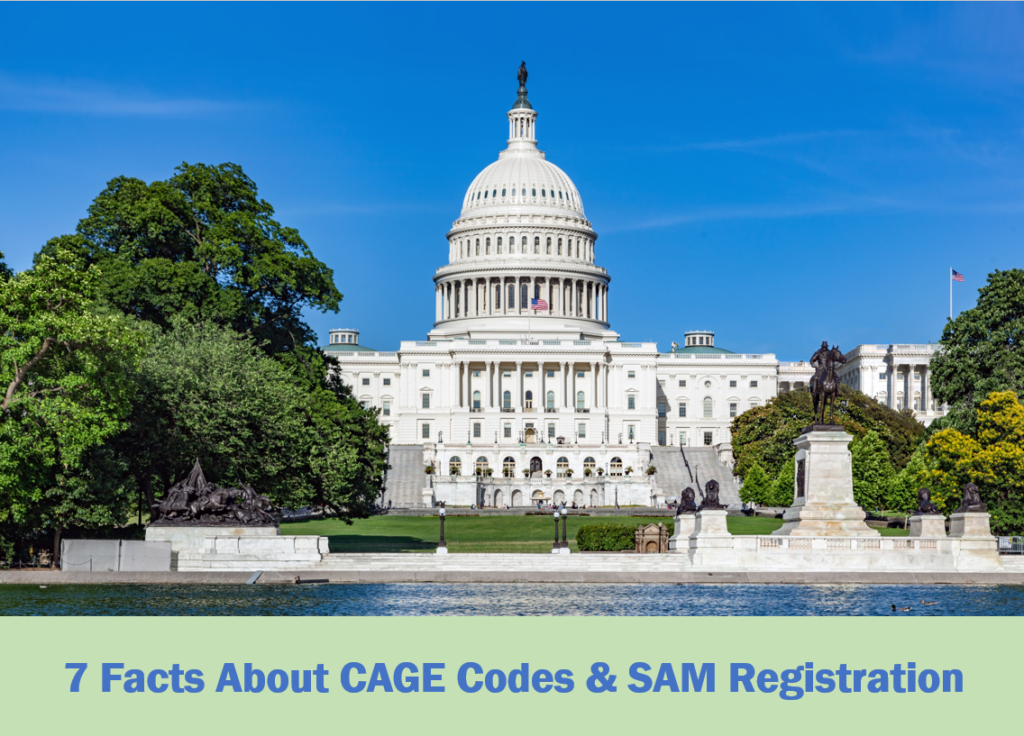
In 2020, the United States government spent more than $600 billion on government contracts. The government can be an excellent source of income for just about any type of company, but you first have to complete your SAM registration and attain a CAGE code. Here are a few quick facts about CAGE codes, SAM registration and government contracting in general.
- SAM Registration Leads You To A CAGE Code
The System for Award Management (SAM) is the database that includes detailed information about all active government contractors. In order to be listed in this database, you must complete the SAM registration process. Once you are approved, the government will issue you a Commercial and Government Entity (CAGE) code.
The CAGE code is your unique identifier within the System for Award Management. Government procurement agents can enter this number into the database and your company and its current status will pop up. Without a CAGE code and active SAM registration, you cannot do business with the federal government or usually with a state government, as they also will want your CAGE code when you bid on contracts.
- You Can Hire Someone To Complete SAM Registration
While the government does not charge a fee for SAM registration, the process is confusing and time-consuming, and many people just opt to hire a third-party registration service rather than spend ten or more hours trying to translate the complicated government-speak in the SAM application. Additionally, if you make mistakes on the application, this can delay your approval and you might not even fully understand how to fix the mistakes.
At Federal Contractor Registry, we’ve handled thousands of SAM registrations for companies of all sizes, from small businesses to large Fortune 500 firms and everything in between. We liken ourselves to accountants, because, while you could complete tax forms on your own for free, the tax code is complicated, and mistakes can be costly. We can complete your SAM registration quickly and accurately so that you can be approved as quickly as possible and get that CAGE code.
- CAGE Codes & SAM Registration Expire
You need to renew your SAM registration every year to remain active as a government contractor. In fact, it is highly recommended that you renew your registration several months in advance. If a government procurement agent is considering your company for a contract but sees that your registration will expire shortly, this might cost you the contract because if you don’t renew, the government cannot work with your company.
The team at Federal Contractor Registry handles initial SAM registrations as well as SAM renewals, so you can hire us if you like. If you aren’t making any changes, you probably will be able to handle the renewal process on your own. However, if you are making changes or if you are unsure if you completed all of the sections of the SAM application correctly when you first signed up, it can be wise to let a third-party handle SAM renewal. We can make sure that every section is filled out correctly and make any necessary changes.
- You Must Complete A Notarized Letter
Because SAM registration isn’t complicated enough, the Federal Service Desk decided to add an extra step in the process a few years ago. When you first sign up with SAM, you must send the Federal Service Desk a notarized letter listing your Entity Administrator. In the past, you could not gain SAM approval or get a CAGE code until this letter was received and filed, but because this caused a massive backlog of SAM approvals, this is no longer the case. However, you do still need to send in the letter as soon as possible.
Instructions for this letter can be found at https://www.fsd.gov/gsafsd_sp?id=gsafsd_kb_articles&sys_id=df025fd01b9d3cd42fe5ed7ae54bcb2c. If you scroll about halfway down the page, you will see three templates. For most applicants, the first template is what you will want to click on. This downloads the sample template letter for a single company or person wishing to become a government contractor. Simply follow the instructions exactly, get the letter notarized and send your completed SAM notarized letter to the Federal Service Desk.
- Do Not Give Anyone Your MPIN
You will often have a procurement agent or perhaps another contractor ask for your CAGE code, and this isn’t a big deal. Your CAGE code is basically a public record and simply identifies you within the SAM database. However, if anyone asks for your Marketing Partner ID Number (MPIN), do not give them this information.
While a CAGE code is public, your MPIN number is essentially a password into the System for Award Management. No one but your company’s Entity Administrator and possibly the company owner (if that is a separate person) or other highly trusted individuals should have this information. If someone has your SAM MPIN, they could get into your SAM listing and make unauthorized changes, so don’t provide this information to anyone, even a government procurement agent.
- There Are Many Obsolete Terms
Government websites and documents are filled with acronyms and special terms that can be difficult to understand. In some cases, you will see terms such as CCR (Central Contractor Registry) and ORCA (Online Representations and Certifications Application). These are old terms for obsolete databases, but you still might see them on websites and even on some government documents. However, everything has been centralized in the System for Award Management, so even if you see a page listing CCR or ORCA, this really just refers to SAM.
One obsolete term that we have seen on a few government websites lately is FedBizOpps or FBO.gov. This was the old search engine that one could use to find government contracting jobs. The current search engine is located at Beta.SAM.gov. So, if you see a webpage suggesting you use FedBizOpps, this is obsolete, and you should just go to Beta.SAM.gov instead.
Some terms you do need to learn include items such as Federal Acquisition Regulations (FAR), Set Asides, North American Industry Classification System (NAICS) codes, Product and Service Codes (PSCs), the Excluded Parties List System (EPLS) and that’s just a short list. Everything in the government is an acronym, so be prepared to learn the language of government-speak.
- Acquiring CAGE Codes Is Just The First Step
Once your SAM registration is approved and you have your CAGE code, there are still a few steps you need to take. Government contract jobs can be lucrative, but they also can be complicated to win. You need to learn all you can about the types of government contracts and how to reply to situations such as Requests for Proposals (RFPs), etc.
The Small Business Administration (SBA) has some helpful tools and resources for small business owners that want to bid on government contracts. State procurement agencies also often host workshops or events where you can learn the ropes of government contracting, and there are a few companies that offer paid workshops and classes as well as companies that will find contracts that match your goods or services and complete the bidding process for you. This can be a good option when you are just starting out.
For small businesses, subcontracting can be a good way to dive into the government contracting world. In this scenario, you provide goods or services for a Prime Contractor, which is a business that has earned a large government contract. They handle all of the heavy lifting, so to speak, and you can build up a government portfolio and learn the ropes from the Prime Contractor. You will still need that CAGE code, though, even if you won’t be working directly with a federal agency.
If you want to start bidding on government contracting jobs, either federal contractor jobs or state contracting jobs, you will need to get that CAGE code. If you would like to hire us to complete your SAM registration, simply click on the green New Registration tab on our homepage and fill out our quick contact form. A registration specialist will be in touch as soon as possible to gather your information and get started on your SAM registration.

